Women in History of Scots Descent
Princess Kaiulani
PRINCESS KAIULANI OF HAWAII "...An overlooked heroine of Scottish heritage: Victoria Ka'iulani Cleghorn, Crown Princess of the Kingdom of Hawai'i, daughter of Princess Miriam Likelike (sister of Queen Lili'iuokalani) and Edinburgh Scot Archibald Cleghorn. Learn the intriguing transoceanic tale of the exquisite and gifted "Hope of Hawai'i". Educated in Britain, friend of Robert Louis Stevenson, Ka'iulani would lose her Royal birthright when American interests overthrew the Hawaiian Monarchy in 1893; after four years semi-stranded in Europe (with one trip to America to plead her Nation's cause), the Princess returned to her homeland, to comfort her people and show solidarity with her Aunt the deposed Queen. Despite her beauty, talent and courage, sorrow and ill health laid Ka'iulani to untimely rest at age 23 in early1899, shortly after her country's annexation to the United States." |
| Article for Electric Scotland They may not be amongst the best lines ever penned by their writer, but the simple verses inscribed in a red plush autograph book belonging to a schoolgirl have unique significance to two cultures a world away from each other. And they were heartfelt verses: Robert Louis Stevenson, one of Scotland’s most famous literary sons, knew his youthful friend and critic - the half-Scottish, half-Hawaiian Princess Victoria Ka’iulani (whose name translates as "royal sacred one" or "the highest point of heaven") - would soon be entering a strange new world for the sake of her education, the world of her Edinburgh-born father…the British Isles far from the island Kingdom home of her birth. |
 Victoria Ka’iulani was named for the Reigning Monarch of England, long a friend to Hawaiian Royalty. (Queen Victoria had been god-mother to Prince Albert, the son of King Kamehameha IV and his consort the part English Queen Emma; Albert, too, would meet a tragic fate - if at a younger age than Ka’iulani - dying of a "brain fever" at age 4. Ka’iulani would travel to England in an elegant frock heavily embellished with peacock feathers, a deliberate echo perhaps, of the famous peacock gown her Aunt, Queen Kapi’olani, wore to Queen Victoria’s Jubilee. Several formal photos were taken of her in this symbolic attire at the outset of her journey.)
Victoria Ka’iulani was named for the Reigning Monarch of England, long a friend to Hawaiian Royalty. (Queen Victoria had been god-mother to Prince Albert, the son of King Kamehameha IV and his consort the part English Queen Emma; Albert, too, would meet a tragic fate - if at a younger age than Ka’iulani - dying of a "brain fever" at age 4. Ka’iulani would travel to England in an elegant frock heavily embellished with peacock feathers, a deliberate echo perhaps, of the famous peacock gown her Aunt, Queen Kapi’olani, wore to Queen Victoria’s Jubilee. Several formal photos were taken of her in this symbolic attire at the outset of her journey.)
From childhood she was raised with complete awareness of the "double race" complexity of her cultural inheritance, and that unusual demands would be placed upon her in preparing to become Queen of a sovereign Pacific Kingdom, whose Indigenous leaders were determined to demonstrate to a Western world still blinded by racial prejudice that their small Nation was as cultured, dignified, and scientifically aware as any of the so-called "Great Powers". (‘Iolani Palace would have electricity before the White House: in March of 1888, Ka’iulani herself was given the honor of "throwing the switch" that illuminated Honolulu for the first time.) Proud of her dual Scottish and Kanaka Maoli ancestry, she would become a Victorian royal equally at home surfing (at which she excelled) as playing croquet; eating poi and raw fish as "pouring out" at elegant afternoon teas; playing tennis as paddling a canoe; admiring demonstrations of hula kahiko (this ancient dance tradition rescued by her uncle the King from missionary-engineered near-oblivion) while herself learning the ballroom dances of Europe. She could sing, play guitar and ukulele, had the intense love of flowers and gardening that came from both her ancestries, and was an expert equestrienne. (Hawaiians had taken to horses immediately, and developed unique riding traditions of their own.) She loved feminine gowns and had a knack for sewing…which stood her in good stead during the latter portion of her European exile, when Americans had overthrown the monarchy and cut of the Princess’ funds from home: her friends commented that Ka’iulani could wrap a length of any old fabric about herself and look exquisite. (Rather like another Princess in a much later time…the ill-fated Diana.) The artistic creativity that was a Kalakaua birthright manifested in the Princess’ love of the "Great Masters" whose works she examined in minute detail in Britain’s and Europe’s museums: her expressed desire was to become a great painter…and some of her youthful efforts - showing promise, if not the sophistication a longer life would have made possible - survive to this day, including a Scottish landscape now permanently on public display in the Picture Gallery of Hawai'i’s Bernice Pauahi Bishop Museum. (Where is her copy of Landseer’s “The Challenge”, one wonders? Intriguing to note Ka’iulani chose to paint this scene of a red stag calling its rivals, for surely red deer remain one of the great icons of Scotland. The skull of such a stag is visible in one of the last photos taken of Ka’iulani at ‘Ainahau, nailed on the outside of the house behind the front lanai.)
"Island Rose", "Island Flower"…"Pua o Hawai'i" (Hawai'i’s Flower), "Rose of ‘Ainahau". Ka’iulani’s memory has evoked the use of all these floral names…and her mystique is irrevocably linked with one of Hawai'i’s favorite scents…that of the Chinese jasmine. It is still believed the Princess loved these delicate blossoms best of all the flowers planted in the grounds of her home estate. And quite literally "…her name has left the fragrance of a flower," (the words of poet Ella Wheeler Wilcox) for to this day the jasmine is called by the Hawaiianized word for "peacock… "pikake"…in tribute to the Princess’ attachment to both jasmine and her elegant avian pets. Even graphics for one version of the seal of the Caledonian Society of Hawai'i - whose web-pages proudly include a tribute to the Princess - contains the multi-stranded pikake-blossom lei as a reference to the importance of the "Rose of ‘Ainahau" in both Hawai'i’s indigenous and Scottish heritage. No-one gives or receives this most cherished lei without remembering Ka’iulani.
Despite this awareness in Hawai'i, Princess Ka’iulani is in some respects a "lost treasure" of the Scottish heritage…an exquisite and gifted Crown Princess still loved and honored in her homeland,
but largely forgotten in the British Isles where she was educated and spent a large portion of her tragically short life. (Granted that understanding of Ka’iulani varies greatly even in Hawai’i: some only know her as a decorative and tragic “fairy tale Princess”; others are aware of her strength of character and purpose as a strong Hawaiian royal who stood up for national independence and the wishes of her people both.)
Aside from a portrait by famed New Zealand artist Kristin Zambucka displayed on the premises of the Wellingborough Golf Club in Northamptonshire (formerly "Great Harrowden Hall", seat of the Barons Vaux, and site of Ka’iulani’s finishing school days), and a replica of her surfboard in the collection of the British Surfing Museum, no public tribute to her memory is known to exist in the British Isles…though she spent time in England, Scotland, Wales and Ireland as well. It is to be hoped that - with the ongoing revival of rich Kanaka Maoli cultural traditions, and the increasing availability of the historical truth in regards to the fate of the Hawaiian Kingdom - Ka’iulani shall assume her place as not only a heroine of the Hawaiian people, but of her Celtic kinspeople a world away.
 Ka’iulani is known to have visited the home of famous opera singer Adelina Patti in Wales; on one of the several trips to Scotland with her father - during which they visited both Edinburgh and Glasgow - she was given the opportunity to handle a book written in by Elizabeth I; in Collington, while a guest of the R. A. MacFie family’s home - Dreghorn Castle - she was asked to plant a maple tree. Does it yet stand? If so, it has fared better than the beloved foliage of ‘Ainahau…long ago consigned to the bulldozer and covered over with cement. (Of the buildings, only one thatch house from ‘Ainahau was reputed to survive into recent times… transplanted to the grounds of the famous "Waioli Tea Room" in Manoa Valley; Stevenson/Ka’iulani enthusiasts in Hawai'i lament its 2003 destruction in a windstorm, although nothing truly original had been part of the oft-rebuilt structure for many years. The regal mansion Archibald Cleghorn lovingly built for his daughter while she was away in Britain was destroyed by fire in the 1920s, after a stint as a small hotel.)
Ka’iulani is known to have visited the home of famous opera singer Adelina Patti in Wales; on one of the several trips to Scotland with her father - during which they visited both Edinburgh and Glasgow - she was given the opportunity to handle a book written in by Elizabeth I; in Collington, while a guest of the R. A. MacFie family’s home - Dreghorn Castle - she was asked to plant a maple tree. Does it yet stand? If so, it has fared better than the beloved foliage of ‘Ainahau…long ago consigned to the bulldozer and covered over with cement. (Of the buildings, only one thatch house from ‘Ainahau was reputed to survive into recent times… transplanted to the grounds of the famous "Waioli Tea Room" in Manoa Valley; Stevenson/Ka’iulani enthusiasts in Hawai'i lament its 2003 destruction in a windstorm, although nothing truly original had been part of the oft-rebuilt structure for many years. The regal mansion Archibald Cleghorn lovingly built for his daughter while she was away in Britain was destroyed by fire in the 1920s, after a stint as a small hotel.)
Ka’iulani was devastated when her British guardian - and "second father" - Theophilus Davies found himself forced to read her the terrible cables breaking the news of the Monarchy’s fall. A handful of white renegade businessmen unwilling to see their interests curtailed by the laws of the Kingdom, conspired and succeeded in forcing Ka’iulani’s beloved Aunt from her throne, with assistance from representatives of the American military (a gunboat with weaponry trained on the Royal Palace, and U.S. Marines landed to supposedly "protect the property" of Americans). A campaign of racist propaganda, and toadying to the disciples of "Manifest Destiny" in Washington, D.C., kept matters in foment until "lame duck" President Cleveland was safely out of office, and the pro-annexation McKinley in his place.
Although her health suffered a blow she was never to recover from (her chronic migraines and constant susceptibility to ailments began soon after receiving the shocking news from home), the Princess was devoted to her people’s interests, a woman "leel and true" in every respect of her noble character…one who could not sit idly by while her country was wrested away from its people. She made her way to America’s shores, and - although not a “public person” by nature - addressed the press with these confident and pointed words:
"Seventy years ago Christian America sent over Christian men and women to give religion and civilization to Hawai'i. Today, three of the sons of those missionaries are at your capitol asking you to undo their father’s work. Who sent them? Who gave them the authority to break the Constitution which they swore they would uphold? Today, I, a poor weak girl with not one of my people with me and all these ‘Hawaiian’ statesmen against me, have strength to stand up for the rights of my people. Even now I can hear their wail in my heart and it gives me strength and courage and I am strong - strong in the faith of God, strong in the knowledge that I am right, strong in the strength of seventy million people who in this free land will hear my cry and will refuse to let their flag cover dishonor to mine!"
The "heathen Princess", the clownish "Princess Koylani" of pro-annexation skits and cartoons, the backward "savage" anti-Monarchy propaganda-merchants tried to paint her as, proved quite a surprise as she traveled across the United States following her education; instead of the caricature cannibal expected, the paparazzi of the day were confronted by an exquisite Royal Princess wearing the latest Paris gowns and speaking cultured English (or ’Olelo Hawai’i, French and German, if the occasion demanded). The continual attempts to present all those of Kanaka Maoli heritage as illiterate "children" incapable of ruling themselves backfired whenever the Hawaiian-Scottish Princess arrived upon the scene. (As a San Francisco Examiner reporter would snort reprovingly in print, "A barbarian princess? Not a bit of it. Not even a hemi-semi-demi-barbarian. Rather the very flower - an exotic - of civilization. The Princess Kaiulani is charming, fascinating, individual." And yet another reporter would note, "She is beautiful…there is no portrait that does justice to her expressive, small, proud face. She…holds herself like a Princess, like a Hawaiian - and I know of no simile more descriptive of grace than this last…Her accent says London, her figure says New York…but her heart says Hawai'i.") She had spoken for her people with authority, as her Ali’i (royal) calling demanded, and her loyalty to her aunt and Queen never wavered. Had it not been for a few cruel tricks of historical fate (such as the outbreak of the Spanish-American war and the coming to power of an American President devoted to the idea of "Manifest Destiny"), Princess Ka’iulani might have turned the tide and truly saved her nation, as Ellen Wright Prendergast credited her with in a honoring song; as it was, many a guilty American conscience must later have endured uncomfortable memories of the noble and courageous Princess, and the truth she represented. Though her efforts in Washington, D.C. failed, the Princess – as late historian Glen Grant noted – continued to work in her Nation’s interest once home, giving one notable lu’au to annexation commissioners…during which the she made certain Hawaiian community leaders could present the anti-annexation petitions their political societies had compiled.
She was only 23 when she died…finally at home in Hawai'i, but health broken by a life-time of losses - of her governess, god-mother, mother, uncle, beloved half-sister, guardian, and country. At two a.m. on the morning of March 6th, 1899, the peacocks dwelling in the 10-acre grounds of her magnificent home estate ‘Ainahau ("land of hau trees" or "cool place") abruptly began to scream…a terrible din which alerted all of Honolulu to the fact that the brave half-Scottish Princess who had traveled so far, seen so much, and made such gallant efforts to save her Hawaiian nation had only returned home to defeat, ill health (it is likely she suffered from thyroid disease), and death. To this day, legend has it that the cherished pets of "The Princess of the Peacocks" knew the spirit of their mistress had fled…some of them becoming so inconsolably raucous as a result that the Princess’ stricken father had to have them shot.
Even her political enemies (who had sneered at her as the “British Princess”, or insultingly suggested the “ex-Princess” could open a jewelry shop!) expressed their grief at her unexpected passing: "It was impossible not to love her," acknowledged the American-controlled Honolulu press.
Despite the continued noble efforts of her aunt the Queen and loyal Royalists to bring America to account for the overthrow of the rightful Hawaiian government (and subsequent illegal annexation of the island nation), with the death of their beloved Crown Princess, many Hawaiians felt that hope for restoration of their Nation during their life-times was at an end. But the influence of the short life of this queenly young woman continues to this very day…inspiring people of many walks of life and differing backgrounds to various achievements in her honor. Two communities (and many individuals with ancestral ties to both) take great pride in her, and justly so.
Today Ka’iulani’s fascinating duality and unbowed Hawaiian spirit inspires artists, musicians, poets and dramatists to creative attempts to evoke its essence, and explore the Princess’ significance to the complicated modern Hawaiian political and cultural scene. The renowned musical duo "HAPA" (whose name reflects the respective Kanaka Maoli/Caucasian ethnic origins of the musicians) have produced one of the loveliest of all the innumerable songs that have been composed in Ka’iulani’s honor since her birth: "Nani Wale o Ka’iulani"… a song perpetuating a 19th century Hawaiian form in which English and ‘Olelo Hawai'i (Hawaiian language) lyrics are mixed together. (Their "In the Name of Love" CD’s cover art features the two original artists dramatically juxtaposed, as same-yet-different cultural/spiritual "warriors", armed with guitars…Keli’i Kaneali’i barefoot, batik fabric around his hips, Barry Flannagan in boots and kilt.) "Our love for you forever will remain…; Nani wale o Ka’iulani, There’s beauty in the sound of your name. Kou aloha mau loa e Ka’iulani…Our love for you forever will remain… Precious flower in the misty rain…"
New books about or including references to the Princess’ life continue to appear, and old ones have been revised or reprinted; the Princess’ tragic story has inspired Russian poetry, and even a major work of science-fiction. Her own words in defense of her country have been rediscovered and now serve as inspiration to a new generation exploring means to insure cultural survival and the correction of wrongs done a sovereign nation.
Paintings depicting the cherished Scottish-Hawaiian princess are everywhere in the Islands…found in schools, hotels, museums and even dress-shops (a famous fashion-line is named for her); a mural of Ka’iulani and Stevenson discussing Scotland under the ‘Ainahau banyan (by artist and Ka’iulani admirer Niki Fuller) graces a wall in Honolulu’s St. Francis Hospice. The Princess has been immortalized in everything from a life-sized wax figure to delicate porcelain statuettes; china plates, music boxes, champagne flutes, diamond-studded cameo brooches, and commemorative coins have carried her image. And while nothing remains of the 10-acre botanical wonderland that Archibald Cleghorn (known as Hawai'i’s "Father of Parks") labored long years to perfect (his gift of it to the new "Territory" of Hawai'i - in hopes it would remain a perpetual park to his daughter’s memory - was rejected)…signs of the rebirth of a "spirit of place" are beginning to appear in overbuilt Waikiki: in October of 1999 a heroic-sized statue of Ka’iulani feeding one of her peacocks made its debut on a small revitalized parcel of the old ‘Ainahau property, to henceforth educate visitors and residents alike about the Princess’ life.
Perhaps the most intriguing and complex artistic homage paid to the Crown Princess in modern times was that of "Ka’iulani: A Cantata for the Theatre"…a production of Honolulu’s prestigious multicultural theatre company, Kumu Kahua. In this highly innovative and politically uncompromising modern play, the Princess is portrayed at one point by two actors simultaneously…a woman of European ancestry, and a woman of Kanaka Maoli. Having met with enthusiasm during its Honolulu, Los Angeles and Washington, D.C. performances, the production traveled on to participate in the Edinburgh Fringe Festival, where its theme of submerged nationhood impressed and moved the Scottish audience…who perhaps found it easy to identify with both sides of the Princess’ heritage…a resonance of historic injustices, and yet unresolved political futures.
Despite its surface aura of tragedy, of promise cut short, Princess Ka’iulani’s "story" is by no means one of failure or defeat…nor is it ended. While most of her biographers close with that sad day on which the Princess was laid to rest in the quiet of the Royal crypt at Mauna ‘Ala, the tale of a subsequent century of Ka’iulani’s influence needs to be told. Although justice for her beloved people has long been deferred, a sense of her spiritual inspiration is ever-increasing…both home in Hawai'i and in the larger world: from the achievements of students at the impoverished but academically excellent school named for her, to the installation of the heroic-sized statue in Waikiki, Princess Ka’iulani’s name is gaining wider and wider recognition. The need for a superb, Hawaiian-culture rooted historical documentary on the Princess’ life – something along the lines of a Ken Burn’s documentary, drawing on the great wealth of historic materials that exist, including the extensive Hawaiian language press of Ka’iulani’s day – is under increasing discussion by artists, cultural practitioners, educators and activists in Hawai’i.
That Ka’iulani’s "Hawaiian-ness" and "Scottishness" are of symbiotic importance is indicated not just by the note taken of her in the usual Scottish cultural venues, but perhaps most tellingly by a document spotted on the internet: "Huaka’i I Kekokia" ("Journey to Scotland"). In the ‘Olelo Hawai'i text created by a language student at the University of Hawai'i, the heart-warming reality of the language’s rebirth (Hawaiian was actively belittled and suppressed after the overthrow, as the demise of the vibrant Hawaiian language press of the time attests) is made manifest in an account of Ka’iulani’s visits to Glasgow and Edinburgh, and…
"…ke kakelo o Dreghorn. Ia lakou i noho ai i laila, ua kowelo ha’aheo ka hae Hawai'i ma ka ‘ale’o o ua hale la. Kaulana keia hale, no ka mea ua kipa mai ka mo’i o Kalakaua i keia hale ho’okahi, a i kona noho ‘ana, ua kono ‘ia’o ia e kanu i kekahi kumu la’au ma Dreghorn. No laila, ua kanu ‘o ia i ’elua kumu la’ua, a i ko Ka’iulani hele ‘ana i laila, ua kono ‘ia’o ua kekahi e kanu i kumu la’au…"
…which describes how Ali’i (royalty) were entertained at Dreghorn Castle (from whose tower the Hawaiian flag was flown in celebration), and invited to plant some very special trees. Whether or not the tree Ka’iulani planted in Scotland survives, the spirit of the Scottish-Hawaiian Rose will live forever.
Mindi Reid is a writer currently living in the Puget Sound region.
The Dirge of Ka’iulani
By
A.R. Rose-Soley, San Francisco, March 1899
“Our Flag! That was pulled down. The Hawaiian Ladies’ Patriotic Society wrote to Admiral Miller, asking to be allowed its possession. He never answered. My own flag, the Royal Standard, was shown to me by a Washington young lady in her drawing room.” -Ex Queen Liliuokalani.
“I have nothing to live for now. They have taken all my life from me.” – Princess Ka’iulani.
*****
Kaiulani! Kaiulani! Princess of the jeweled seas,
Kaiulani! Kaiulani! sighs the scented tropic breeze.
Kaiulani! dove-notes echo through palm fronds and darkling trees.
Kaiulani! Thy brown nation, mourning lowly on its knees,
Moans and wails in plaintive cadence, draining sorrow to the lees,
And the burden of its sadness over reef and ocean flees.
Send back our Flag!
Oh men of white ambition and of power,
Who robbed our Daughter of her queenly dower,
Relent to this, her dark, her silent hour
Give back our Flag!
Above her where she lies, a fragile flower,
Stricken where ruthless hands despoiled her bower,
While we crouch round, our tears a blinding shower,
Hang up our Flag!
Send back our Flag!
Ye mock us with white sympathy and sigh,
With formal speech, strange flag hung half-mast high,
No flag have we above her tomb to fly,
Give back our Flag!
What boots it that our nimble fingers ply,
That leis of royal shade about her lie,
That royal kahili still meets the eye?
Give her her Flag!
Send back her Flag!
Ye broke her heart, oh men with white men’s greed,
Her royal heart, with grasping word and deed,
All careless of a royal virgin’s need,
Give back her Flag!
‘Tis such a little thing for which we plead,
Little to you, for have ye not decreed,
That all Hawaii’s treasures are your meed?
Return her Flag!
Send back our Flag!
Ye won it not, ye wrenched it. We were free
To worship our own chiefs of high degree---
Ye trampled on them and their royalty,
Give back her Flag!
Shall your white women hold it fast,
and She
Who sleeps among the moaning of the sea,
Even in Death’s sad sleep despoiled be?
Bring back her Flag!
Send back our Flag!
Ye came and preached your tale of love to all,
Of God’s great tenderness whate’er befall,
Of white man’s answer to brown man’s call,
And stole our Flag!
Doth not our legend ‘mid your precepts fall---
How runs it? “Mene Mene, on the wall”---
Ah, lest your pride of greatness fade and pall,
Give back our Flag!
Send back our Flag!
“They took my life,” our darling made her moan,
Have ye no pity, are your hearts of stone?
Unto her heart, now pulseless, and alone,
Give back the Flag!
Kaiulani! Kaiulani! Princess of the jeweled isles,
Kaiulani! whom our love and gladness evermore beguiles,
Can’st thou hear the sound of weeping, rising thro’ they palm-crowned aisles?
Where thy royal mamo woos his golden mate with feathered wiles,
Where we crouch beneath thy banyan while the white man struts and smiles,
Can’st thou hear the sound of weeping, rising thro’ thy palm-crowned aisles?
-- As Published in The Independent, Honolulu, May 13th, 1899
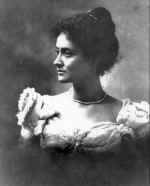
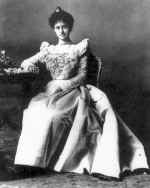
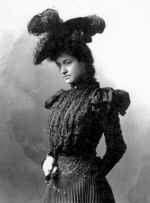
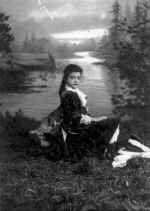
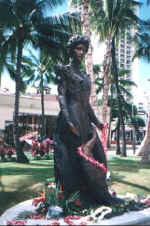
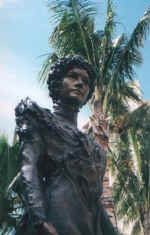
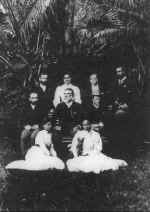

No comments:
Post a Comment